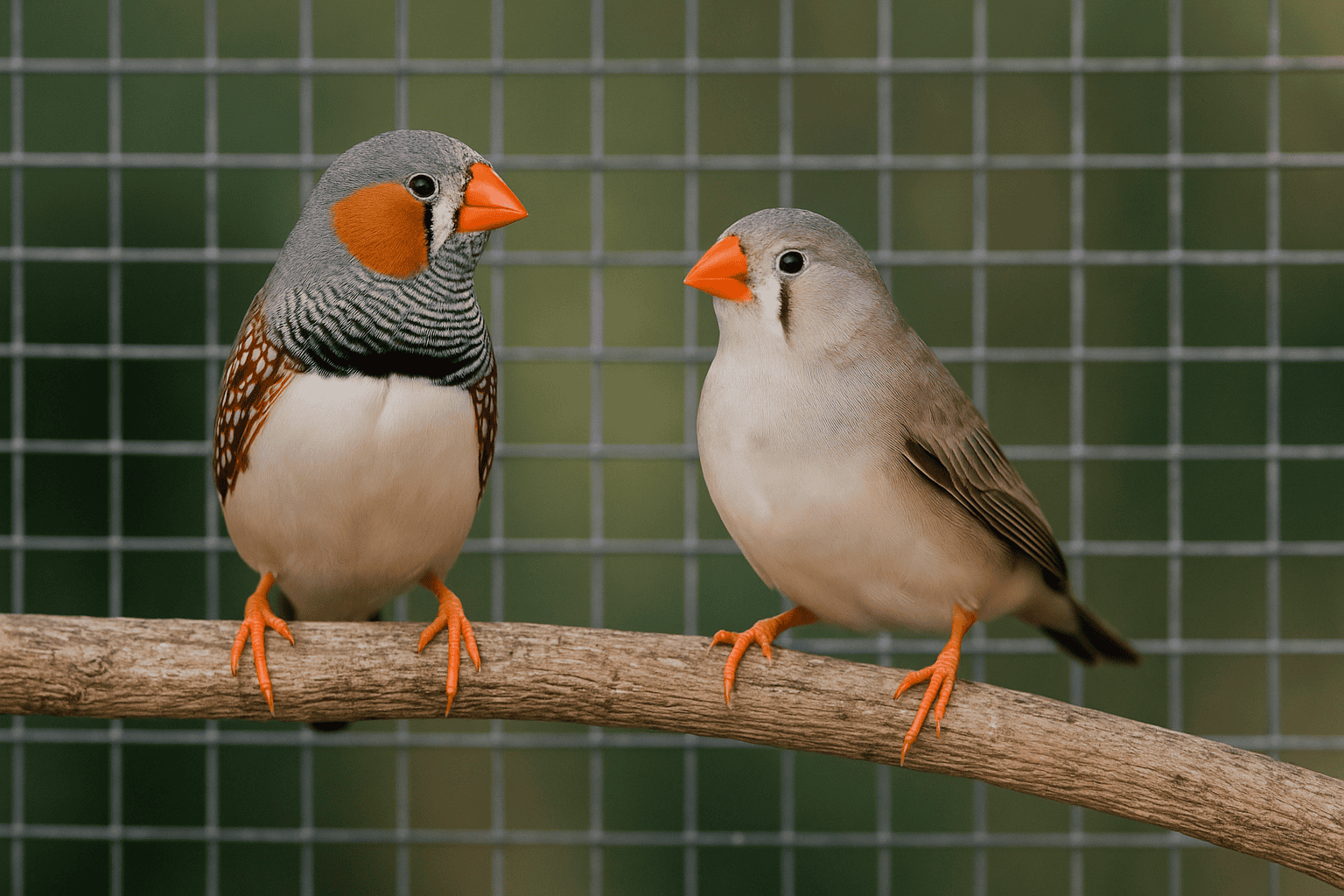The Allure of Finches as Companion Birds
Imagine waking up to the soft, cheerful peeps of tiny birds flitting playfully from perch to perch. No squawking, no cage-rattling chaos—just delicate feathered friends bringing color and calm into your living space. This is the quiet magic of keeping finches as pets.
Finches aren’t just birds. They’re graceful little marvels of nature that fit neatly into even the smallest homes. Unlike parrots or cockatiels, finches don’t demand constant interaction or attention. They’re perfectly content to go about their day, hopping, chirping, and nesting, as you watch from the sidelines—like nature’s theater in a cage.
A Glimpse Into the Finch World
Finches are small, often no more than 4–6 inches in length, but their personalities and plumage are anything but modest. Their conical beaks are designed for cracking seeds, and their vocalizations range from soft chatters to intricate, almost hypnotic, songs. Some, like the Zebra Finch, sing melodies that rival wind chimes, while others, like the Gouldian Finch, seem more content to let their colors do the talking.
Here’s a quick look at how finches compare to other common pet birds:
| Feature | Finches | Parrots | Canaries |
|---|---|---|---|
| Size | Small (4″–6″) | Medium to Large (7″–40″) | Small (4″–5″) |
| Noise Level | Low | High (Many are loud) | Medium (Males sing often) |
| Interaction Need | Low | High | Medium |
| Social Requirement | Must be kept in pairs/groups | Can live alone (with attention) | Can live alone |
| Cage Size | Wide and long preferred | Tall and spacious | Small to moderate |
Why Finches Are the Unsung Heroes of Aviculture
There’s something comforting about their simplicity. You don’t have to teach a finch tricks or train it to talk. They don’t scream for attention or nip at your fingers. Instead, they offer quiet companionship, a gentle background soundtrack, and an endless source of visual delight as they interact with each other.
They’re also incredibly low maintenance compared to larger birds. Clean the cage, provide fresh food and water, and let them fly within the bounds of a roomy cage or aviary. That’s it. No daily one-on-one sessions. No worrying about social withdrawal if you leave the house for a few hours.
“Watching finches interact is like tuning into a tiny soap opera—full of drama, affection, and unspoken alliances.”
The Responsibility That Comes with Feathered Freedom
Still, like any pet, finches deserve more than just seed and space. Responsible finch ownership means understanding their social structure, meeting their environmental needs, and ensuring ethical sourcing—no wild-caught birds, ever. Many finches available in pet stores are bred in captivity and adapt well to aviary life, but some require a more experienced hand.
Finches can live anywhere from 5 to 10 years depending on the species. That’s a long-term commitment to the well-being of something that, at a glance, looks so fragile. But give them what they need, and they’ll repay you with beauty, peace, and the kind of joy that only quiet creatures can bring.
Understanding Finch Temperament and Social Needs
“Hands-Off” Nature vs. Observational Enjoyment
Finches are not birds you train to sit on your finger or learn tricks on cue. And that’s exactly what makes them so enchanting.
Unlike parrots, who thrive on physical interaction and human attention, finches are observers—not performers. They don’t want to perch on your hand or nuzzle against your cheek. Instead, they invite you into their world from a respectful distance. You become the silent audience to a dynamic show of flutters, hops, courtship dances, playful bickering, and curious exploration.
Think of them more like fish in an aquarium—fascinating to watch, deeply therapeutic, but not meant to be handled. Attempting to tame them through frequent touch or forced handling can lead to stress, injury, or trust breakdown. For those who appreciate quiet companionship and low-interference bonding, finches are the perfect match.
“They don’t sit on your shoulder—but they’ll dance in the air just for you.”
The Critical Need for Social Companionship
While they don’t crave human touch, finches absolutely require the company of their own kind. In the wild, these birds form large flocks, constantly chattering, foraging, and grooming in tandem. Isolation, even in a comfortable cage, can be devastating to their mental health.
Let’s take a quick look at social behavior comparisons:
| Finch Type | Can Live Alone? | Prefers Pair? | Best in Groups? |
|---|---|---|---|
| Zebra Finch | ✖ No | ✔ Yes | ✔ Yes |
| Society Finch | ✖ No | ✔ Yes | ✔ Yes |
| Gouldian Finch | ✖ No | ✔ Yes | ✔ Yes (Cautious with housing) |
| Cordon Bleu Finch | ✖ No | ✔ Yes | ✔ Yes |
| Java Finch | ✖ No | ✔ Yes | ✔ Yes |
As the table shows, nearly all captive finches must be housed in at least pairs, and often do best in small colonies—provided you maintain enough space and resources.
Warning: Mixing species without research can lead to bullying, especially in smaller enclosures. Peaceful finches like Society Finches may thrive in mixed aviaries, while more territorial types, such as Gouldians or Cutthroat Finches, may need space or same-species companions only.
Legal and Ethical Sourcing of Finches
One of the most overlooked—but vital—responsibilities of finch ownership is where and how you acquire them.
While most pet finches available in the market today are captive-bred, certain species—especially rarer, more exotic ones—may still be taken from the wild illegally or irresponsibly bred in poor conditions. This not only threatens wild populations but also brings fragile, traumatized birds into homes where they may not survive.
Always look for:
- Captive-bred confirmation from reputable breeders or pet stores
- Licensing information when dealing with rare species (e.g., Java Finch in some U.S. states)
- Clean, spacious, and well-maintained breeding environments
- Health guarantees and return policies
A single unethical purchase may unintentionally support wildlife trafficking or inhumane breeding mills. Ethical sourcing not only protects the birds—it supports the future of responsible aviculture.
“When you choose a finch, you’re not just adopting a bird. You’re preserving a species’ dignity.”
Popular Finch Species for Captive Environments: Detailed Profiles
Zebra Finches (Taeniopygia guttata)
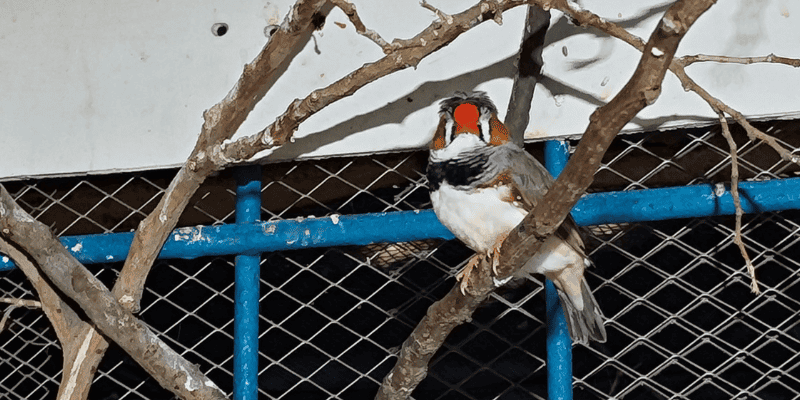
Zebra Finches are often considered the gold standard for beginner aviculturists. Their bold black-and-white facial stripes, orange beaks, and cheerful chatter make them both visually and audibly charming.
Characteristics: Small (4 inches), hardy, comes in numerous color mutations like pied, fawn, black cheek, and more. Males are more vibrant with cheek patches; females are subtler in appearance.
Temperament & Suitability: Extremely beginner-friendly. Hardy, active, and social. Thrive in both cages and aviaries.
Social Needs & Housing: Do best in pairs or small groups. Should not be kept alone. Compatible with other peaceful finch species.
Diet & Maintenance: Low maintenance. Basic diet includes a finch seed mix, greens, and cuttlebone. Easy to breed.
See more details about zebra finches mutations here: Zebra Finch Mutation Calculator
and if you wan o know more about zebra finch breeding guide, see The Complete Guide to Breeding Zebra Finches
Society Finches (Lonchura striata domestica)
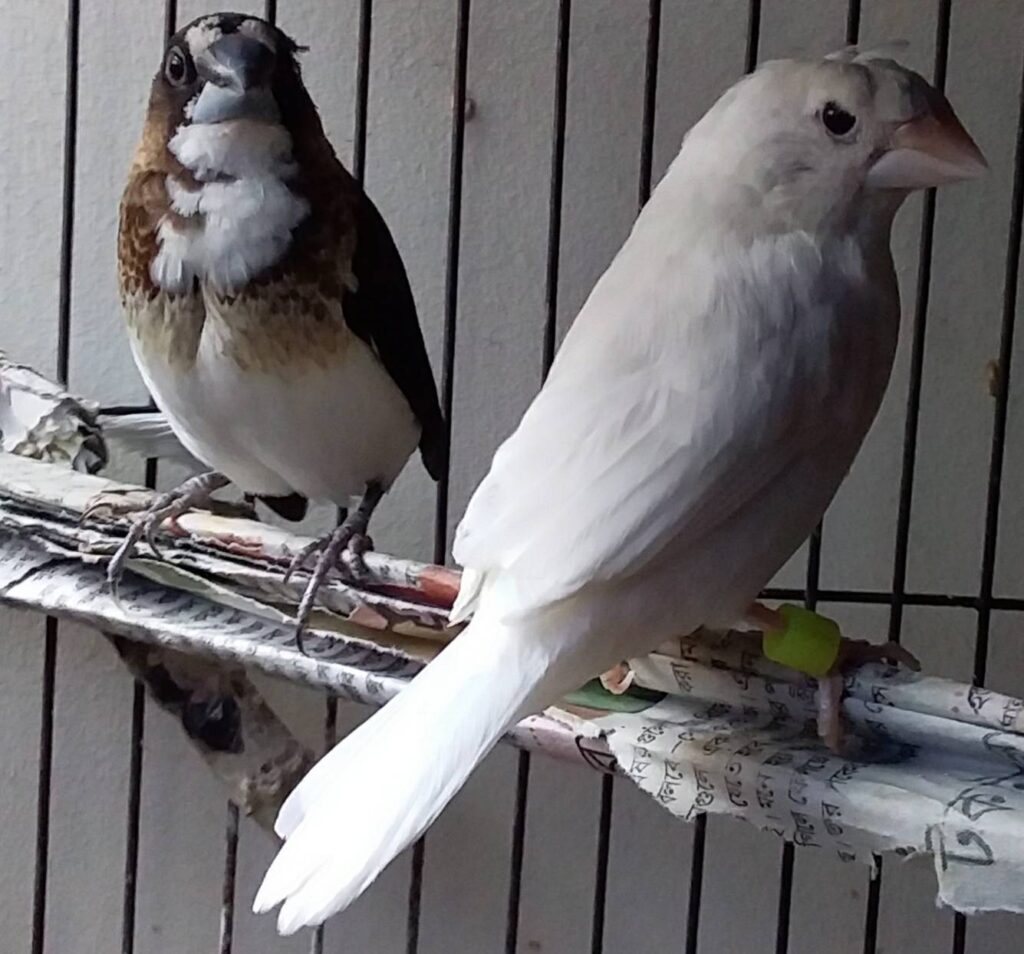
Also called “Bengalese Finches,” these birds are not found in the wild and exist solely as domesticated companions.
Origin & Adaptability: Result of generations of captive breeding. Come in browns, whites, and pied patterns.
Characteristics: Average size (4.5 inches), sturdy build, soft chirping vocalizations.
Temperament & Social Needs: Extremely peaceful and social. Ideal for communal aviaries. Excellent foster parents for other finch species.
Sexing & Vocalizations: Males sing soft, rhythmic songs. Females are quieter and more reserved.
Gouldian Finches (Chloebia gouldiae)
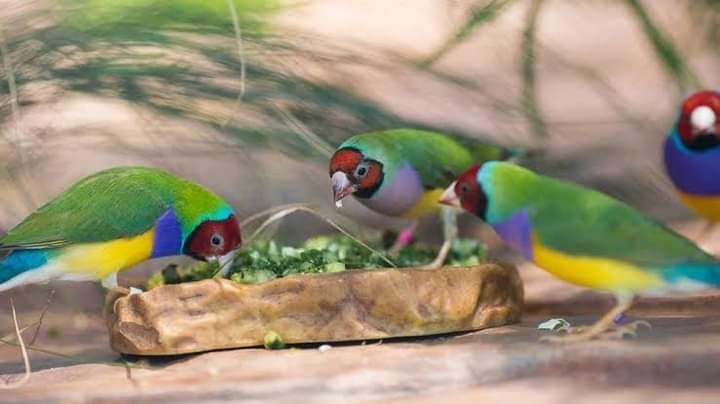
Nicknamed the “rainbow finch,” Gouldians are prized for their dazzling colors—red, black, or orange heads, green backs, purple chests.
Characteristics: Medium-sized (5.5 inches), very colorful but delicate.
Health & Hardiness: Require stable temperatures and good hygiene. Susceptible to air-sac mites and stress-related illness.
Housing with Other Species: Should not be housed with aggressive or highly active species.
Care Level: Intermediate to advanced due to temperature and health sensitivity.
Star Finches (Neochmia ruficauda)
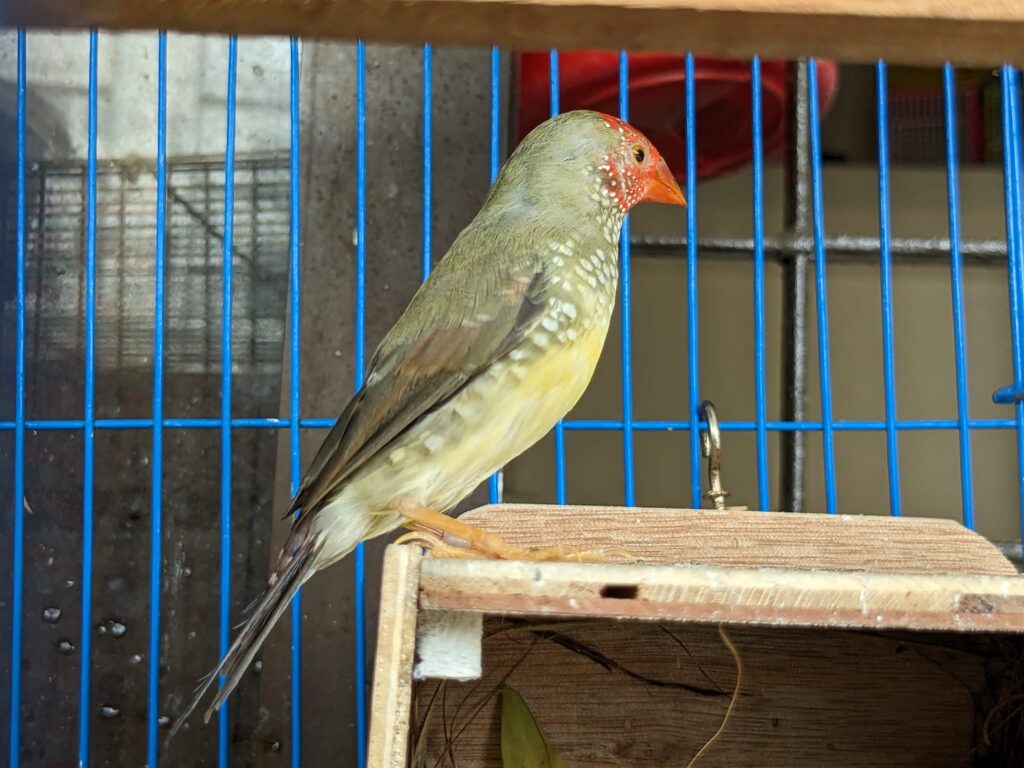
These finches feature red faces, greenish backs, and white dot markings across the body.
Characteristics: Around 4 inches long. Attractive and cheerful.
Suitability: Hardy, easy to care for.
Temperament & Social Needs: Gentle and compatible with other peaceful finches.
Breeding: Breeds readily in cages and aviaries.
Chestnut Munia (Lonchura atricapilla)
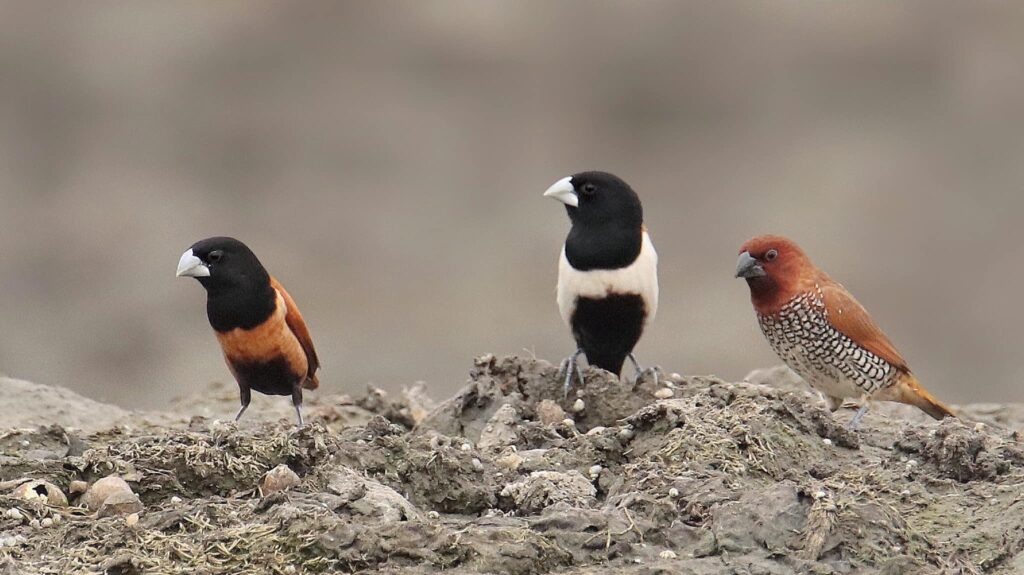
Known as the black-headed munia, these birds have striking contrast between their dark heads and chestnut bodies.
Characteristics: Stocky build, about 4.5–5 inches.
Temperament & Compatibility: Peaceful, group-oriented, non-aggressive.
Diet & Foraging Habits: Ground foragers. Prone to overgrown nails.
Special Considerations: Sensitive to cold. May hybridize with other Munia species.
Cordon Bleu Finches (Uraeginthus spp.)
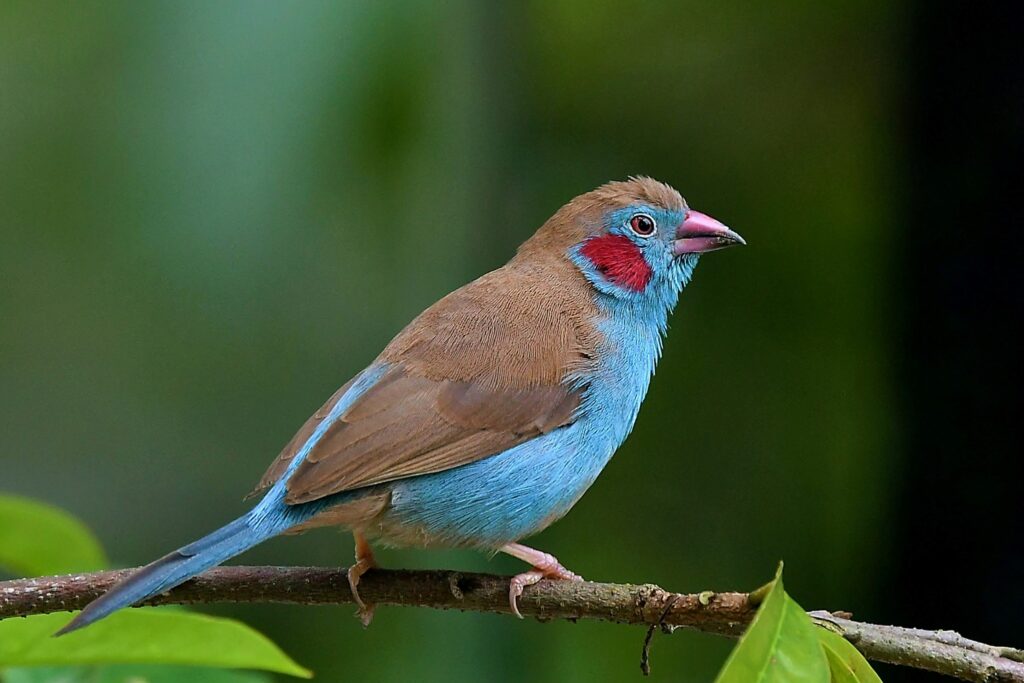
Also called Blue Waxbills, known for their sky-blue coloration and red facial accents (in some species).
Origin & Size: East Africa. Small (4 inches).
Temperament & Social Needs: Social, fast-moving, best in pairs or small groups.
Diet: High-protein diet with insects or egg food.
Housing & Temperature Sensitivity: Sensitive to drafts and temperature shifts.
Breeding Considerations: Shy breeders; do best in aviaries.
Cutthroat Finches (Amadina fasciata)
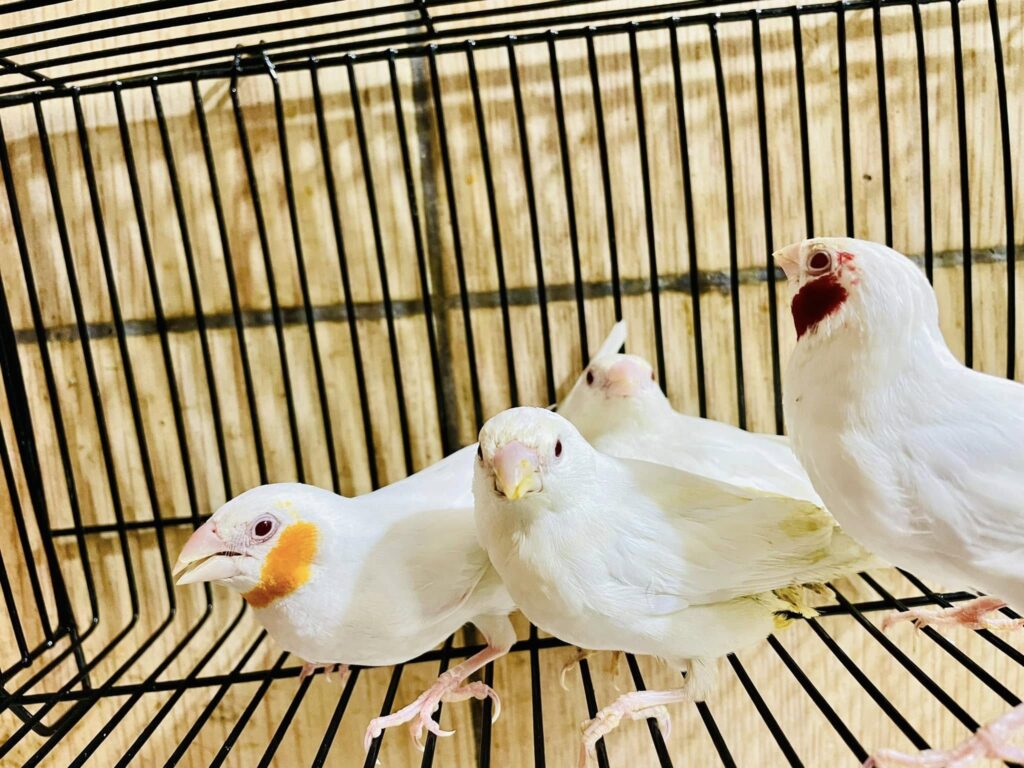
Named for the distinct red band across the male’s throat.
Lifespan & Diet: Up to 10 years. Needs variety in diet, including insects.
Housing & Exercise Needs: Active—needs spacious aviary.
Health Concerns: Prone to melanism, rickets, parasites.
Breeding: Can breed in captivity. Some colony breeding success.
Fire Finches (Lagonosticta spp.)
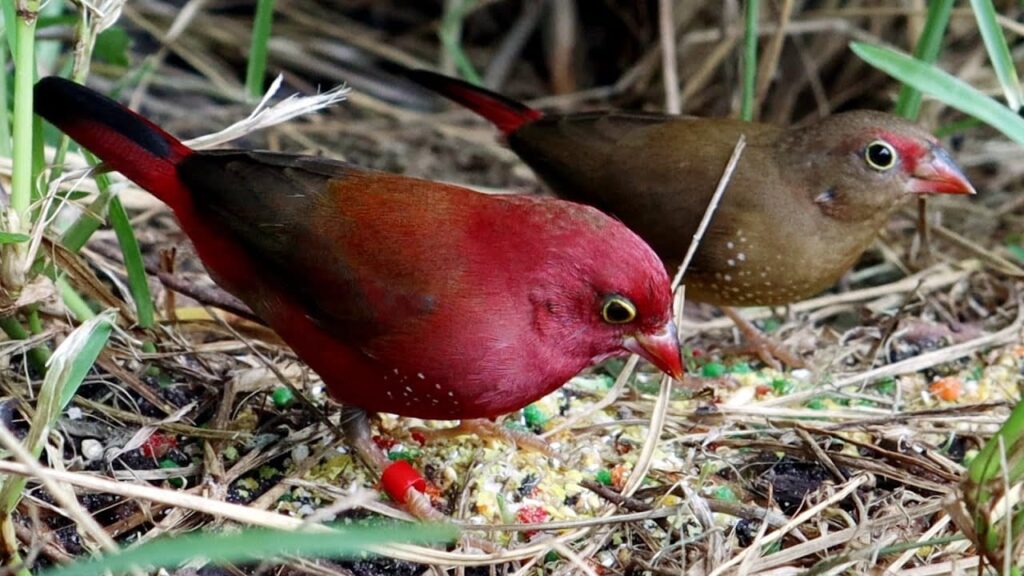
Bright red coloration on males; females are duller.
Origin & Habitat Preference: Dry, sunny areas. Avoids cold, damp places.
Temperament & Compatibility: Gentle. Can hybridize—caution in mixed aviaries.
Diet & Stress Sensitivity: Sensitive to poor diet and stress.
Nesting Behavior: Secretive ground or near-ground nesters.
Java Finches (Lonchura oryzivora)
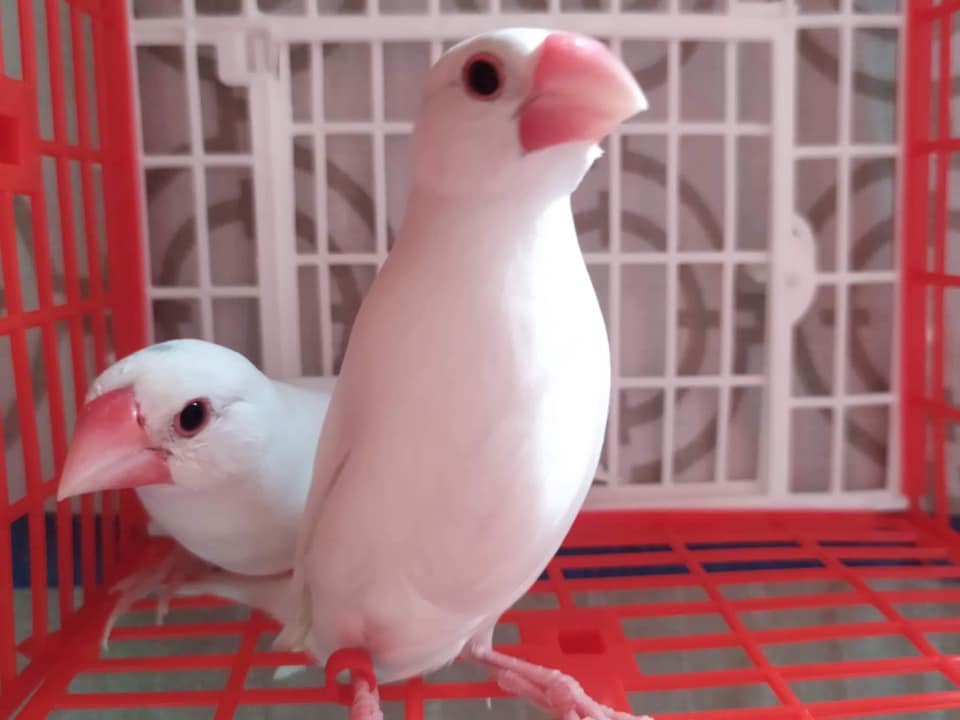
Also known as Java Sparrows, these large finches are bold and social.
Origin & Size: Southeast Asia. Around 5.5–6.5 inches.
Legal Status: Restricted in some U.S. states (e.g., California).
Diet: Primarily seeds; supplement with pellets, greens, protein.
Breeding: Easy to breed if space and diet are adequate.
Lavender Waxbill (Estrilda caerulescens)
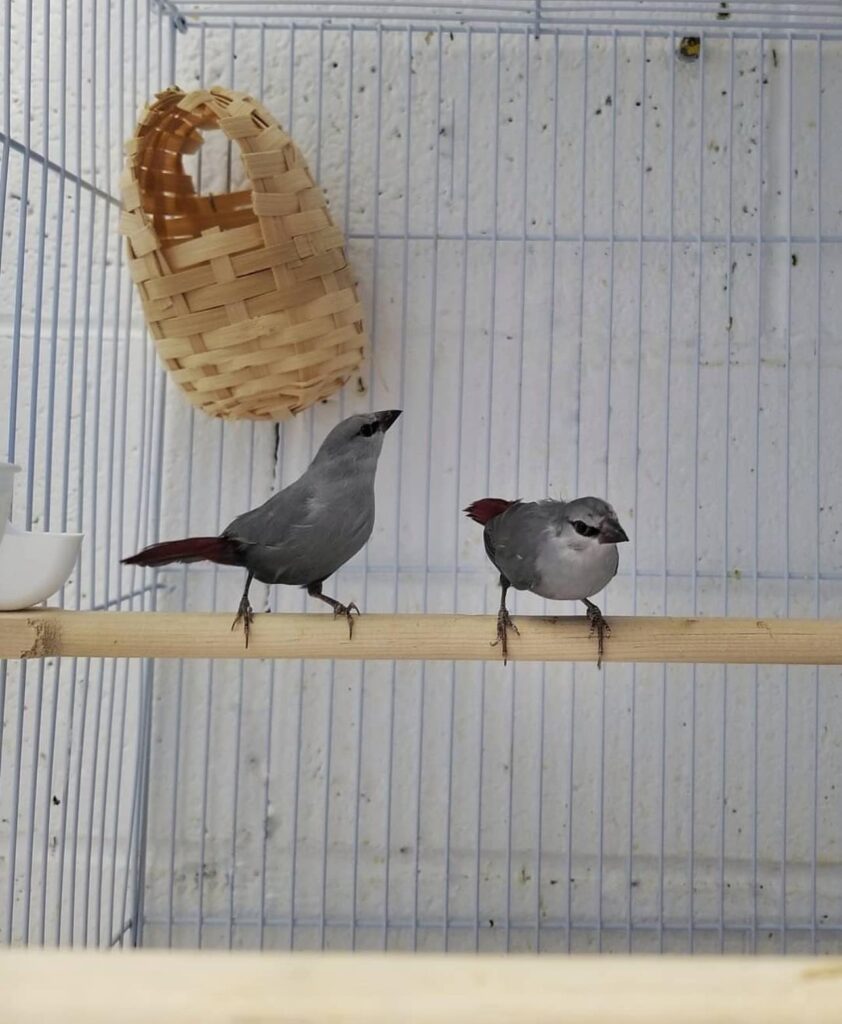
Known for their lavender-blue hue and delicate frame.
Origin & Size: Tropical Africa. 4.5 inches.
Temperament & Social Needs: Active, fast fliers. Can be aggressive with other waxbills.
Housing: Not suitable for small cages—needs flight space.
Diet: Insectivorous; live food essential.
Health Concerns: Sensitive to cold and plucking behavior.
Breeding: Can be tricky. Prone to abandoning nests.
Masked Finches (Poephila personata)
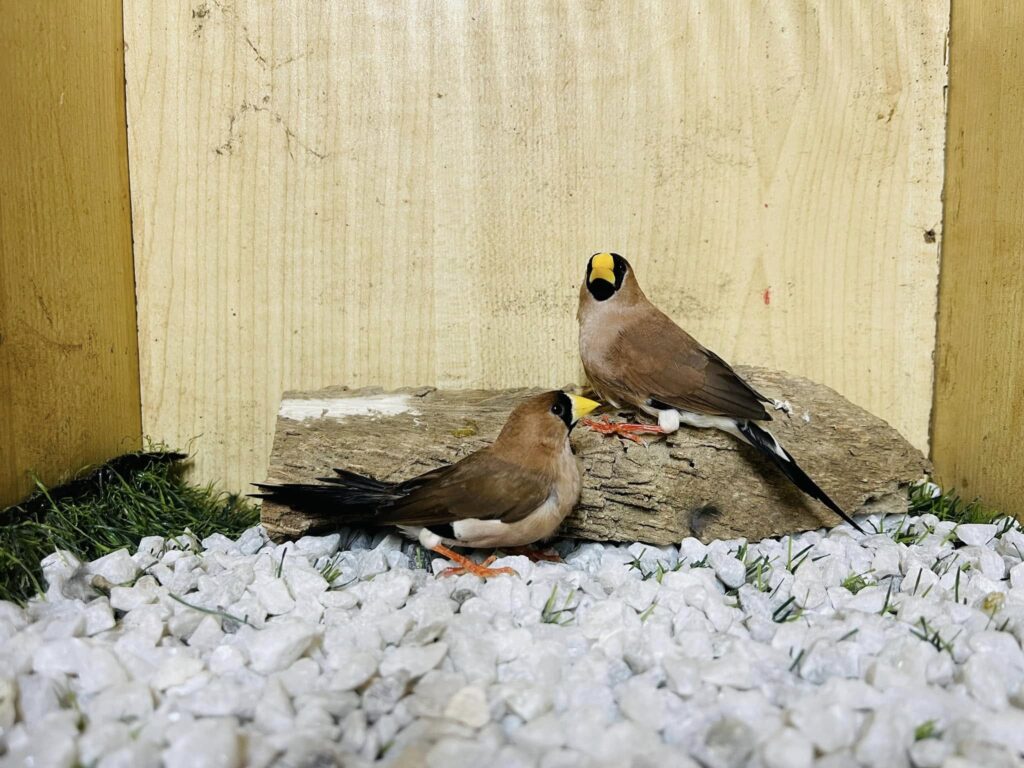
Feature a black facial mask and elegant golden-brown body.
Housing & Compatibility: Can live in colonies or mixed aviaries if monitored.
Diet: Seed mix, greens, insects during breeding.
Breeding: Nest privacy is critical. Easily stressed.
Health: Ground foragers—monitor for parasites.
Owl Finches (Stizoptera bichenovii)
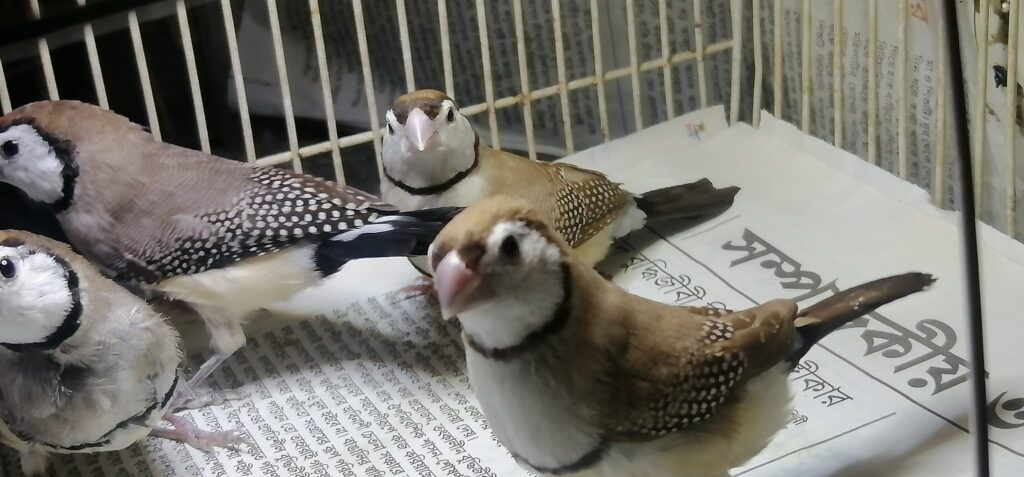
Also known as Double-barred Finches, with black bars resembling spectacles.
Temperament & Social Needs: Playful and curious. Thrive in flocks.
Housing: Requires spacious enclosure.
Temperature Sensitivity & Drafts: Avoid cold or breezy areas.
Diet: Varied diet including seeds, greens, grubs.
Health Concerns: Prone to mites and respiratory issues.
Painted Firetail Finches (Emblema pictum)
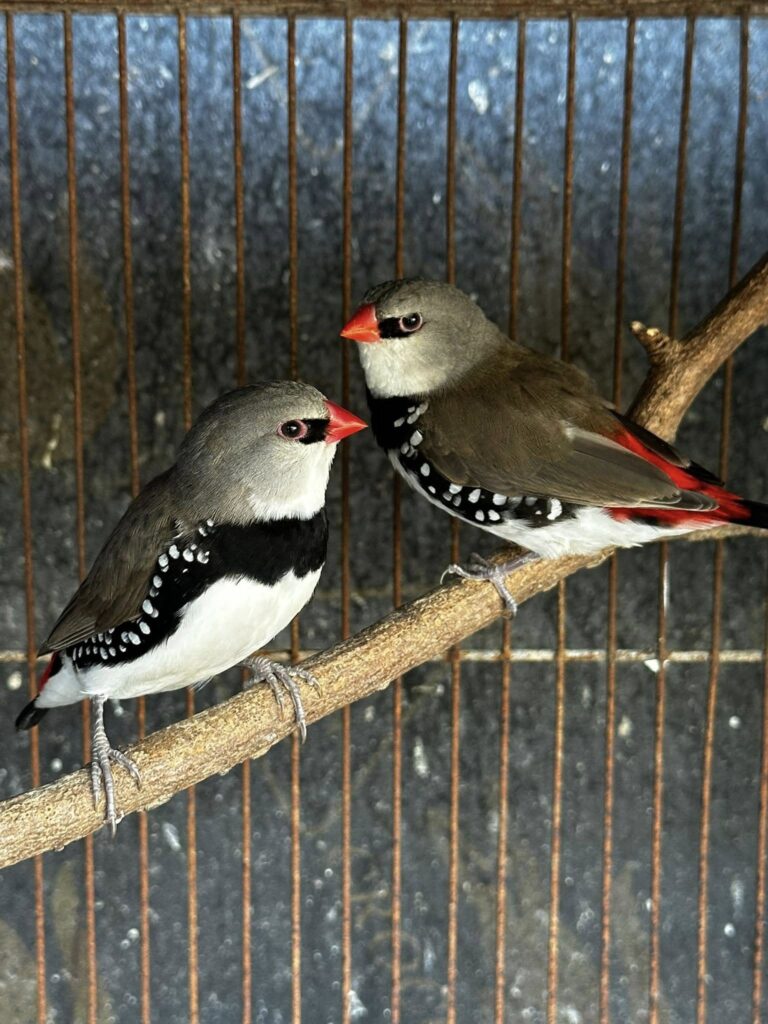
A bold red face, rump, and spotted flanks make them stand out.
Ease of Maintenance & Temperament: Quiet, shy, non-aggressive.
Housing: Prefers larger aviaries.
Temperature Tolerance & Humidity: Low tolerance for humidity.
Diet: Seed mix, live food during breeding, calcium-rich supplements.
Breeding: Ground nesters, breed well in calm settings.
Plum-headed Finch (Aidemosyne modesta)
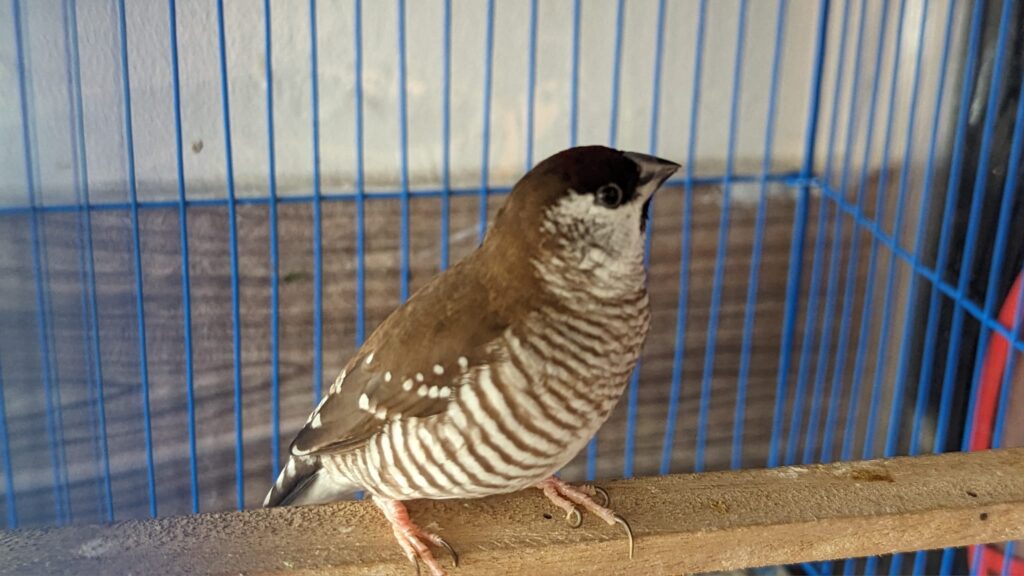
Features a purplish-brown head and a mellow personality.
Temperament & Breeding: Friendly and prolific breeders.
Housing: Dry, draft-free aviaries.
Diet: Soft food, live food, greens.
Health: Needs regular parasite treatment.
Shaftail Finches (Poephila acuticauda)
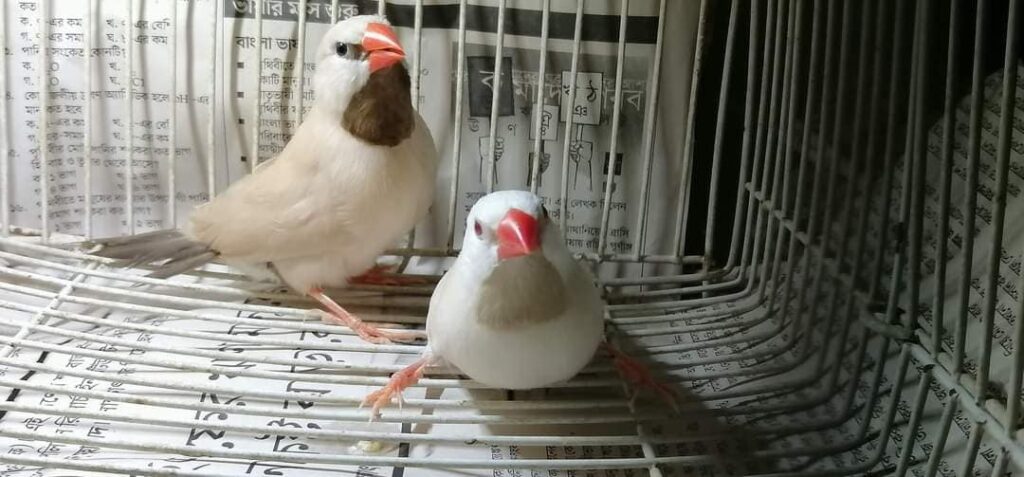
Also called Long-tailed Finches, with distinct tail streamers.
Characteristics: Active, vocal, entertaining.
Temperament & Compatibility: Great for mixed aviaries. Non-aggressive.
Housing: Large enclosures needed to prevent obesity.
Diet: Balanced seed mix, fruits, insects in season.
Temperature Needs: Needs warmth in winter.
Spice Finch (Lonchura punctulata)
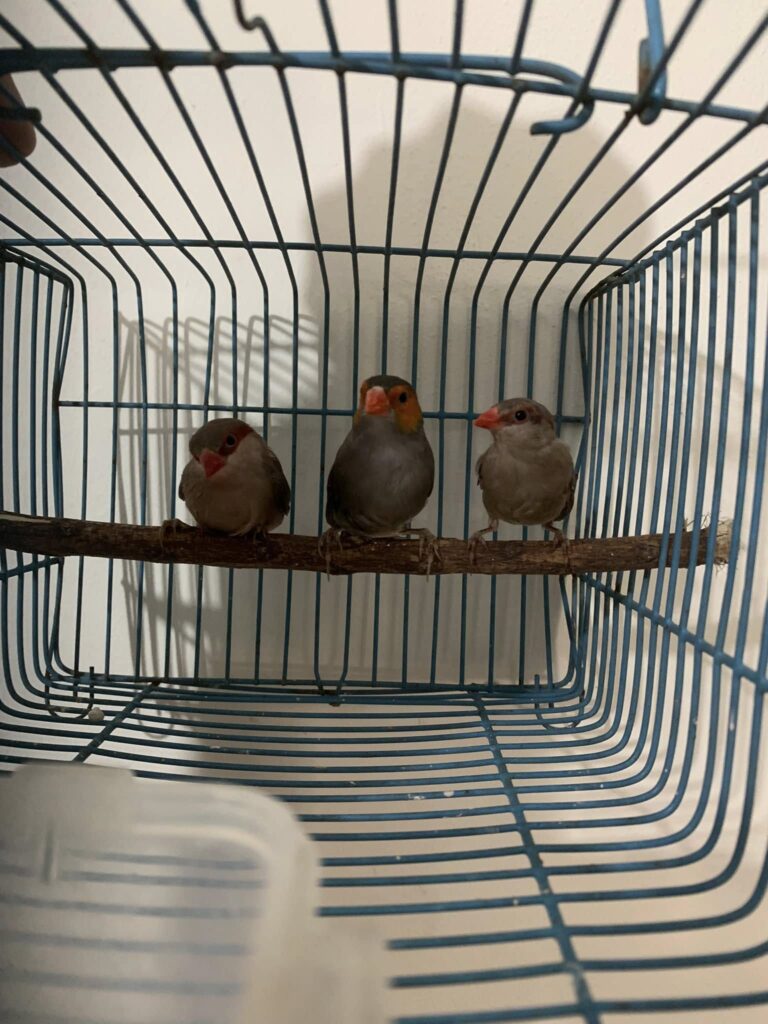
Also called Scaly-breasted Munia due to its feather pattern.
Characteristics: Gentle disposition, earthy coloration.
Temperament & Compatibility: Calm and adaptable. Great in community aviaries.
Diet: Standard seed diet, enjoys some soft food.
Breeding: Breeds easily in colonies.
Housing: Does well in moderate-sized cages or aviaries.
Amadina Finch (Amadina erythrocephala or Amadina fasciata, depending on species)
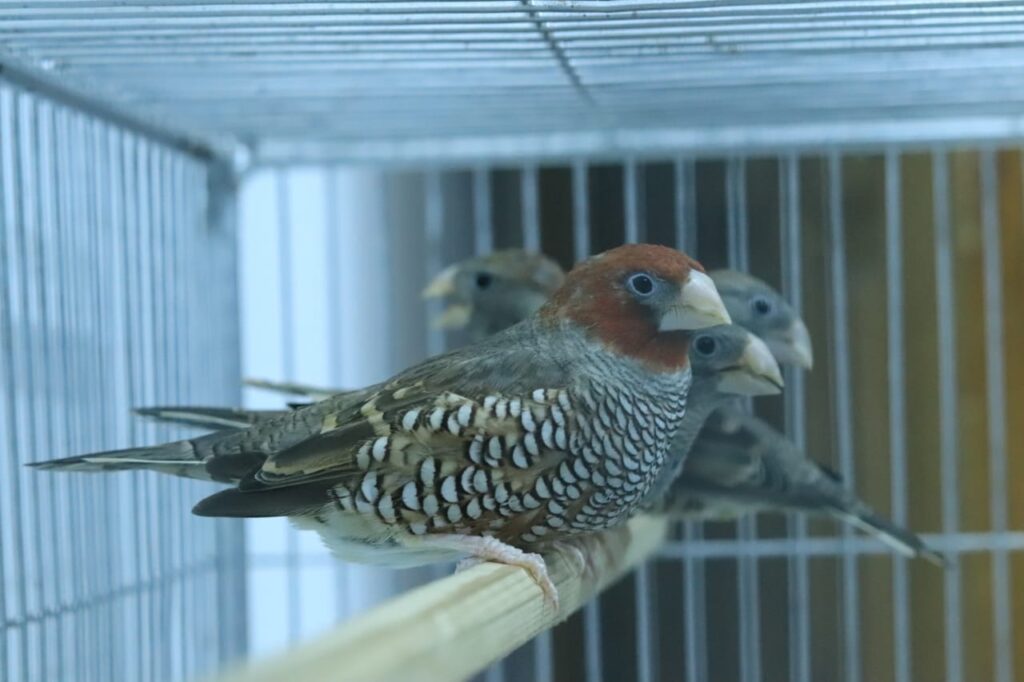
Alternative Names or Distinctive Identifier:
Often referred to as the Cut-throat Finch due to the red band across the throat in males (for A. fasciata).
Characteristics:
Stocky build with brown and beige plumage, spotted breast, and a striking red “cut-throat” mark in males. Females lack the red throat but share similar body coloration.
Temperament & Compatibility:
Moderately aggressive during breeding season, especially toward smaller or more passive finches. Outside of breeding, they’re generally calm and can be housed with similar-sized or assertive species.
Diet:
Thrives on a seed mix with added millet and canary seed. Also enjoys leafy greens, insects like mealworms (especially during breeding), and mineral supplements.
Breeding:
Eager breeders, often using grass-lined nests or nesting boxes. Males display courtship behaviors like singing and hopping. Require a quiet, secure space for successful breeding.
Housing:
Do best in spacious cages or aviaries that allow flight and territory separation during breeding. Avoid overcrowding and provide natural perches and nest options.
Parrot Finch (Erythrura spp.)
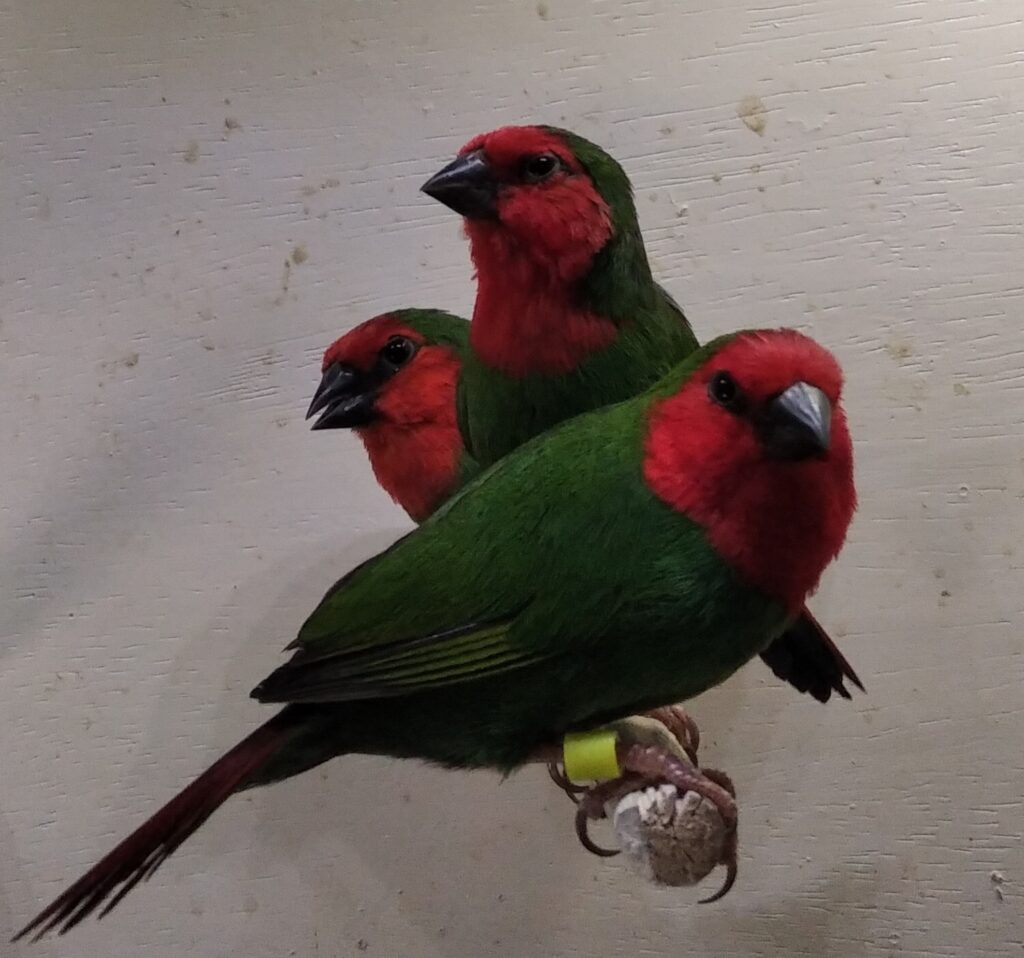
Alternative Names or Distinctive Identifier:
Known for their bright, parrot-like coloring—typically a vivid mix of green, blue, and red depending on the species (e.g., Red-headed Parrot Finch, Blue-faced Parrot Finch).
Characteristics:
Compact, vibrant birds with a short, strong beak and energetic behavior. Their striking coloration and active nature make them standout additions to aviaries.
Temperament & Compatibility:
Generally peaceful but can be territorial during the breeding season. Best kept with similarly sized and temperament-matched finches. Thrive in planted aviaries where they can explore and forage.
Diet:
Requires a more varied diet than many finches. In addition to a quality seed mix, they need regular access to fresh greens, soft food, and live food such as mealworms or fruit flies—especially during breeding and molting.
Breeding:
Can be shy breeders. Prefer well-concealed nests with plenty of plant cover or privacy. Nesting success improves in quiet environments with minimal disturbance.
Housing:
Best suited for large, well-planted aviaries that offer both flying space and dense cover. Cages must be enriched and secure, with consistent access to natural light and humidity.
Designing and Maintaining the Optimal Finch Habitat
Creating a safe, stimulating, and health-conscious environment is crucial for your finch’s long-term well-being. A proper habitat mimics natural conditions while ensuring the comfort and security of your birds. Let’s explore how to design a space that keeps your finches active, healthy, and stress-free.
Cage Selection and Dimensions
Finches are horizontal fliers, not climbers. Their cages should prioritize length over height, allowing them to fly back and forth rather than hopping up and down. For a pair of finches, the minimum recommended cage size is 30 inches wide x 18 inches deep x 18 inches high, but larger is always better.
Key considerations:
| Feature | Recommendation |
|---|---|
| Shape | Rectangular, long cages (not round) |
| Bar Spacing | 1/4 to 1/2 inch to prevent escape/injury |
| Material | Powder-coated metal, stainless steel, or non-toxic paint/coating |
| Doors | Easy access without risk of birds escaping |
Avoid cages with decorative bars or hazardous materials like zinc, which can be toxic when ingested through nibbling.
Strategic Habitat Placement
Where you place your finch cage is as important as the cage itself. These birds are sensitive to environmental changes and require a steady, secure atmosphere.
Ideal placement factors:
- Away from kitchens and bathrooms: Toxic fumes, smoke, and aerosol sprays can be deadly.
- Natural light: Position near a window for daylight exposure, but avoid direct drafts or overheating.
- UVB lighting: If indoors full-time, provide UVB full-spectrum lighting for vitamin D synthesis.
- Quiet but active area: Choose a room with regular human activity but not high noise levels.
Keep cages off the ground to reduce stress and exposure to foot traffic or curious pets.
Essential Cage Accessories
The right setup enhances your finch’s health and prevents boredom. Keep the following accessories in your habitat:
| Accessory | Purpose |
| Perches | Offer various diameters and textures (natural wood, rope) to prevent foot fatigue |
| Food & Water Dishes | Stainless steel or ceramic, cleaned daily |
| Nest/Hideouts | Breeding pairs need nests; others appreciate cozy hideouts |
| Enrichment Toys | Swings, mirrors, natural branches, grass bundles to stimulate curiosity |
| Cuttlebone | Provides calcium and keeps beak trimmed |
Rotate enrichment items weekly to maintain interest and mental stimulation.
Daily and Weekly Cleaning Protocols
Finches are tidy, but their cages require regular upkeep to prevent illness and odors.
Cleaning schedule:
| Task | Frequency |
| Replace water, remove uneaten food | Daily |
| Wipe perches and high-traffic areas | Daily |
| Replace cage liner or bottom paper | Every 2–3 days |
| Deep clean entire cage (soap + water, bird-safe disinfectant) | Weekly |
| Wash toys and perches | Weekly or biweekly |
Avoid bleach or strong disinfectants unless they are labeled bird-safe and always rinse thoroughly. Use a natural enzyme cleaner designed for birds if needed.
Creating a clean, engaging, and safe habitat isn’t just about aesthetics—it’s about giving your finches the best life possible in captivity. Next, let’s explore how to fuel that life with proper nutrition.
Nutritional Guidelines for Captive Finches
Feeding your finches well is the foundation of their health, vibrancy, and longevity. Like any living creature, finches thrive on a balanced diet that mimics their natural foraging habits. Understanding what to feed—and how—is key to keeping these lively birds happy and healthy.
Components of a Balanced Diet
Finches naturally consume a variety of seeds, greens, insects, and fruits in the wild. To replicate this diversity in captivity, consider the following dietary components:
| Food Component | Purpose and Tips |
|---|---|
| Pellets | Nutritionally balanced, formulated to provide essential vitamins and minerals missing in seed-only diets. Pellets should form the bulk of their diet (around 60-70%). |
| High-quality Seed Mix | A mix of millet, canary seed, and other small seeds. Avoid mixes heavy in sunflower or high-fat seeds, which can cause obesity. |
| Fresh Vegetables | Leafy greens like spinach, kale, and dandelion greens supply fiber and micronutrients. Offer in small amounts daily. |
| Fresh Fruits | Apples, berries, and melons provide vitamins and hydration but should be given sparingly due to sugar content. Remove uneaten portions quickly. |
| Protein Sources | Live or dried insects (mealworms, crickets), boiled egg bits, or commercially prepared insect protein help during breeding or molting seasons. |
| Calcium and Mineral Supplements | Cuttlebones or mineral blocks are essential for beak health and eggshell strength. Also consider powdered supplements sprinkled on food. |
Variety is vital! Rotate foods to provide a broad spectrum of nutrients and keep your finches interested in their meals.
Feeding Practices
Just like humans, finches appreciate variety and stimulation around mealtime. Here are some tips to promote healthy eating habits and mimic natural behaviors:
- Offer fresh food daily and remove any leftovers promptly to prevent mold and bacterial growth.
- Encourage foraging by scattering seeds, hiding treats in leafy branches, or using specialized foraging toys. This stimulates mental activity and prevents boredom.
- Avoid over-reliance on high-fat seeds, such as sunflower or safflower seeds, which can lead to weight gain and health issues.
- Provide clean water daily for drinking and occasional bathing.
- Monitor appetite and weight regularly to catch any early signs of illness or dietary imbalance.
Pro Tip: During breeding or molting seasons, increase protein intake by adding live or dried insects to support feather growth and energy needs.
By paying close attention to diet and feeding practices, you ensure your finches not only survive—but thrive with radiant plumage, strong health, and boundless energy.
Common Health Issues and Preventative Care
Keeping your finches healthy is not just about good food and a comfy home — it also means knowing the common health challenges they might face and how to prevent them. Early detection and proactive care can make all the difference between a happy flock and a stressful vet visit.
Common Diseases and Symptoms
Finches, like all birds, are susceptible to a variety of illnesses caused by fungi, bacteria, parasites, and viruses. Here’s a quick guide to some of the most common ailments:
| Disease Type | Common Illnesses | Symptoms to Watch For |
|---|---|---|
| Fungal | Aspergillosis | Labored breathing, lethargy, weight loss, respiratory distress |
| Bacterial | Mycoplasmosis, Enteritis | Diarrhea, swollen abdomen, ruffled feathers, reduced activity |
| Parasitic | Air sac mites, lice, intestinal worms | Excessive scratching, feather plucking, respiratory noises, visible parasites |
| Viral | Polyoma virus, Avian Pox | Sudden death, lethargy, swelling, lesions on skin or mucous membranes |
Other general warning signs include changes in appetite, fluffed feathers for extended periods, abnormal droppings, difficulty flying, or changes in vocalization.
Preventative Care
Prevention is always better than cure. Here’s how to keep your finches in tip-top shape:
- Regular Vet Visits: Schedule check-ups with an avian veterinarian at least once a year, or sooner if you notice any abnormal behavior or symptoms.
- Grooming: Keep their nails trimmed and beak in good shape; provide cuttlebones and perches of varying textures for natural beak wear.
- Clean Environment: Maintain daily and weekly cage cleaning routines to reduce pathogens and parasites.
- Behavior & Weight Monitoring: Observe your birds daily for signs of illness. Healthy finches are active, alert, and social. Weigh them weekly to detect sudden weight loss or gain.
- Quarantine New Birds: Isolate new additions for at least 30 days before introducing them to your existing flock to prevent disease spread.
- Balanced Nutrition: Support immune health through a varied and balanced diet, rich in vitamins and minerals.
- Stress Reduction: Avoid overcrowding, sudden temperature changes, loud noises, or frequent disturbances that may weaken their immune system.
Understanding and responding quickly to health issues will help your finches live longer, happier lives. A well-cared-for finch is a vibrant, chirpy companion that brightens your home every day.
Conclusion: A Rewarding Avian Companion
Finches are more than just colorful little birds—they are lively, engaging companions that bring a unique charm to any home. Their cheerful chirping, graceful movements, and social interactions provide endless observational joy without the noise or fuss of larger pets. Whether watching a pair perform their delicate courtship dance or seeing a flock interact in perfect harmony, finches offer a peaceful yet captivating presence that enriches daily life.
But with this joy comes responsibility. Ethical sourcing ensures that the finches you welcome into your home are healthy, legally obtained, and sustainably bred. Creating a proper habitat that mimics their natural environment supports their well-being and happiness. A balanced diet tailored to their nutritional needs keeps them vibrant, while attentive health care—regular vet visits, clean living spaces, and close monitoring—prevents common illnesses and extends their lifespan.
By embracing responsible ownership, you not only give your finches the best chance at a long, healthy life but also nurture a meaningful connection with these fascinating little birds. Their beauty and spirited personalities repay your care with companionship that’s truly rewarding.
Whether you’re a first-time finch owner or an experienced bird enthusiast, the world of pet finches is full of discovery and delight. With the right knowledge and care, these tiny feathered friends can become cherished members of your family.
Recent Posts
The Ultimate Owl Finch Cage Size Guide: More Than a Cage, It's a World
You’ve done it. You’ve brought home one of nature’s most charming creations, the Owl Finch. You watch, mesmerized, as this tiny, feathered jewel explores its new surroundings. But then, a...
The Ultimate Guide to the Owl Finch Breeding Season: A Story of New Life
There is a moment every bird keeper dreams of: a faint "peep" from the nest box that signifies new life. Yet, for many, the path to that moment feels daunting. The questions surrounding the Owl Finch...

